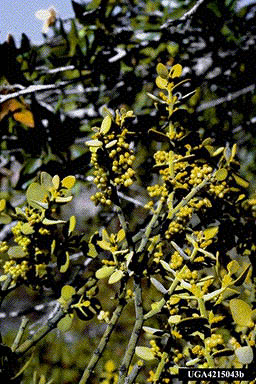Mistletoe
Natural History

Leafy mistletoe with green fruits | Photo credit: R. L. Anderson - USDA Forest Service
Mistletoe plants are found throughout the South and are common in Florida. Mistletoe was once believed to have magical and medicinal properties, and has long been associated with Christmas celebrations.
This plant can infect most hardwoods. Mistletoe is not considered a major threat to trees, but can cause some growth loss and damage to branches. In severe cases, mistletoe can weaken a tree, making it more vulnerable to insects and diseases.
Mistletoe is an evergreen plant that produces sticky seeds that are carried to tree branches by animals, birds, and rain. Once on the host tree, the seeds germinate and send out a peglike root to tap into the tree's vascular system. Mistletoe can only break into young, thin bark. The mistletoe removes water and essential nutrients from the host tree, but mistletoe is not a complete parasite, because it does make its own food.
Be careful not to confuse mistletoe (Phoradendron spp.) found in Florida with the dwarf mistletoe (Arceuthobium spp.) that is a serious problem in the western United States. Dwarf mistletoe and the mistletoe common in Florida (referred to as leafy mistletoe) are not related species, and differ greatly in the damage they can cause.
